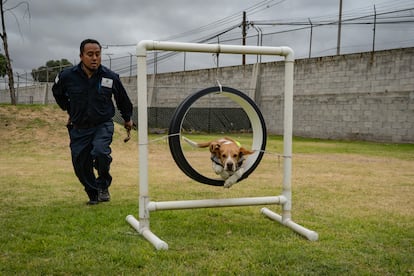Indiana is a large breed dog. She is Creole, but it would appear that she has pit bull features. María Lourdes de Alarcón, her instructor, guides her on a leash. Both train inside a nursery that aims to simulate the weather conditions of the town of Catazajá, in Chiapas, southern Mexico, where the climate can reach temperatures between 35 and 40 degrees. Normally the heat in there would be tiring, but due to the cold front in the country the practice has become more bearable. It is a controlled space where the canine unit prepares to prevent parasites and diseases from entering Mexico. She still has two months of training left, but once ready, together with five other dogs, they will become the next generation of inspectors (four-legged) under the command of the National Service of Health, Safety and Agri-Food Quality (Senasica), who will act as an additional filter to try to stop the spread of the cattle worm plague (GBG).
The Dog Training Center (Ceacan) It is hidden in the municipality of Tecámac, in the State of Mexico, almost like a government secret. This unit, which is part of Senasica, has been operational since 2012. They have trained 76 generations, or the equivalent of more than 300 dogs, to detect plant protection products at airports, truck terminals or border points. Given the emergence of GBG in northern Mexico and Central America, this institution has focused its most recent efforts on specialized training of canine pairs to collaborate in the detection of this parasite. GBG is an infestation caused by fly larvae. Cochliomyia hominivoraxresponsible for the disease myiasis, in which fly larvae infest the living tissues of humans or animals, feeding on them.
As of October 2025, Mexico has reported more than 9,000 cases of worm myiasis, of which 839 remain active and 8,366 have concluded. The majority was recorded in the state of Chiapas, with 4,416 cases. The plague is widespread in the south-east of the country, mainly in Tabasco, Yucatán, Campeche, Quintana Roo, southern Veracruz, Oaxaca and part of Puebla.
Indiana is part of the second generation of dogs specializing in GBG detection and has been in training for four months. His graduation will take place in December of this year and he will join the first generation that will be assigned to Catazajá for almost a year. At Tecámac, Verónica Montes, an expert trainer in Ceacan binomial training, explains that the training process for the detection of this parasite involves several phases. Initially the dogs were golden retrievers, labradors or Belgian shepherds, but given the impossibility of constantly obtaining this type of specimen, it was decided to look for candidates in shelter centers to give homeless dogs a second chance.
“We take advantage of what nature offers us. Most shelter dogs are street dogs and to survive they have developed the olfactory ability to want to feed themselves. They travel kilometers to get a piece of toast, a piece of bread, whatever they find. This is another advantage for us,” says Montes.
However, not everyone manages to be selected. To be a four-legged inspection officer, candidates must undergo rigorous medical checks, possess skills such as hyperactivity, a taste for play and even be greedy. This is because the training uses the positive method (without punishment), rewarding the dog’s work with treats (food) or toys, such as a ball or an object to bite. “Also, it must be a dog in balance with the presence of other people, with other dogs and also with other types of animals, such as livestock,” explains Montes.

The pre-selection phase, the olfactory training for plant protection products, the specialization to identify the GBG and the subsequent training to create a bond with one’s “canine handler”, last in total about nine months. Back at the greenhouse, Indiana begins to sniff a stockyard, which is a facility for handling and holding livestock. Inside there is a sleeve with several holes that contains small bottles with different aromas, resembling a cow’s back. In some there is food. In others, he uses blood gauze from tick wounds or a scratch from the same caged animal; as well as a gauze with blood samples from a sample contaminated by the worm. The Indiana’s predominant coat color is black, but with its white paws it would appear as if it were wearing latex gloves like a human inspector. It stands on two legs and leans on empty space. He smells one of the containers in detail and then sits down indicating his find. Alarcón, her instructor, congratulates her and rewards her for her good work.
In the field, what you would do after reporting the dog would be to brand that animal Already (chalk or pastel) for cattle so that the sample can be examined in detail. The jar Indiana found contains gauze containing the blood of cattle infected with a worm. Although this specimen is old, it has a purplish-red color and has a strong and penetrating smell of rotten meat. These samples, obtained in the field, are taken for training and then stored refrigerated. The teaching process lasts approximately seven days. The concentration of the aroma is intense at first, but as the days go by it loses strength. “This helps the dog to be precise and detect the lesion in minimal concentrations,” explains the trainer.
Part of GBG’s specialization also includes agreements with Birmex (Biological Products and Reagents Laboratories of Mexico), which has horses, or with UNAM, in Topilejo, south of Mexico City, where the dogs practice detection in the presence of live animals to work on their concentration.

Montes explains that an average of 3,000 animals are checked every day in Catazajá and, in almost a year, around 50 cases of GBG have been detected. “We cannot say that the dogs have detected them all, but in the vast majority they participate and where they mark (when they sit) they are detected. The dog is the filter of an entire inspection structure. It is not the whole thing. I always give the example of a funnel. The dog is in the largest mouth. Why? Because it is moving,” adds Montes.
At Ceacan, the dogs have different types of virtual scenarios, such as a baggage claim area at the airport, with a conveyor belt included. In it, Bibi, a small mixed-breed dog who previously worked at Guadalajara Airport in Jalisco, shows how she detects fruit in suitcases located in that simulation area. Or Harry, with pointed ears that make him look like a wolf, who also demonstrates his skills in another space that recreates the hold of a bus.
The dogs also have a large garden space, with lots of green grass, with obstacles, where they can run and exercise daily. In this space, Maiden, a “Beagle-type” dog who is close to retirement at 10 years old, still has the agility and strength to climb platforms and do somersaults. With his energy he wants to demonstrate that he still has strength and that he is not just a specialist in the detection of HLB (Huanglongbing), considered the most devastating bacterial disease of citrus fruits in the world, another of the specialties taught at Ceacan.

Montes says it’s not just about giving an abandoned dog a second chance and a home, but also about ending the nation with the protection of agriculture, livestock, or in this case, preventing the GBG plague from continuing to spread. Indiana is happy and just about ready to serve her country, whether it’s getting a gift, a pet, or some quality time with her favorite toy.



